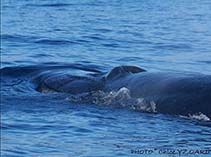Balaenoptera brydei Olsen, 1913
Bryde's whale| Native range | All suitable habitat | Point map | Year 2050 |

|
| This map was computer-generated and has not yet been reviewed. |
| Balaenoptera brydei AquaMaps Data sources: GBIF OBIS |
Classification / Names Common names | Synonyms | CoL | ITIS | WoRMS
Mammalia | Cetartiodactyla | Balaenopteridae
Environment: milieu / climate zone / depth range / distribution range Ecology
Pelagic-oceanic; depth range 300 - 700 m (Ref. 116491). Tropical; 90°N - 90°S, 180°W - 180°E
Distribution Countries | FAO areas | Ecosystems | Occurrences | Introductions
Indo-Pacific, Atlantic Ocean, and the Mediterranean. Tropical to temperate climates.
Length at first maturity / Size / Weight / Age
Maturity: Lm ? range ? - ? cm Max length : 1,460 cm TL male/unsexed; (Ref. 1522); 1560 cm TL (female); max. reported age: 60 years (Ref. 79555)
Inhabits tropical and warm temperate waters in major oceans between approximately 40°N and 40°S. They are generally restricted to waters warmer than 20°C. Feeds on copepods, euphausids, and fishes. Its longevity is approximately 60 years with a maximum size approaching 1500 cm. It is distinguished by its three distinct head ridges (Ref. 79555). Maximum depth from Ref. 114954. Inhabits tropical and warm temperate waters in major oceans between approximately 40°N and 40°S. They are generally restricted to waters warmer than 20°C. Feeds on copepods, euphausiids, and fishes (Ref. 79555). In Madeira, they can be found alone or in groups of two to five between June and November. Foraging includes both searching for prey and prey capture. Lunges are considered feeding dives while other deep dives were foraging dives without prey capture (Ref. 114954).
Life cycle and mating behavior Maturity | Reproduction | Spawning | Eggs | Fecundity | Larvae
Main reference
References | Coordinator | Collaborators
Rice, D.W. 1998. (Ref. 1522)
IUCN Red List Status (Ref. 130435)
CITES status (Ref. 108899)
Appendix II: International trade monitored
CMS (Ref. 116361)
Not Evaluated
Threat to humans
Human uses
Fisheries: commercial
| FishSource | Sea Around Us
Tools
More information
Internet sources
BHL | BOLD Systems | CISTI | DiscoverLife | FAO(Publication : search) | Fishipedia | GenBank (genome, nucleotide) | GloBI | Gomexsi | Google Books | Google Scholar | Google | PubMed | Tree of Life | Wikipedia (Go, Search) | Zoological Record
Estimates based on models
Preferred temperature
(Ref. 115969): 1.3 - 8.4, mean 1.9 (based on 27415 cells).
Price category
(Ref. 80766):
Unknown.



